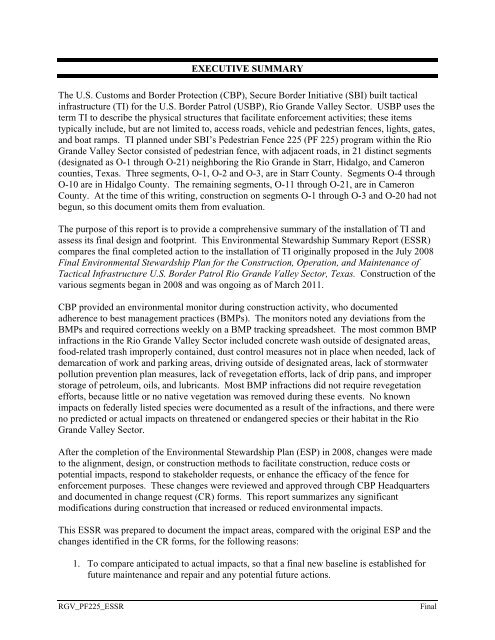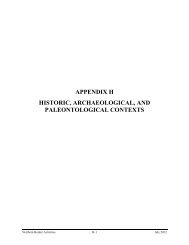Rio Grande Valley PF225 ESSR - CBP.gov
Rio Grande Valley PF225 ESSR - CBP.gov
Rio Grande Valley PF225 ESSR - CBP.gov
Create successful ePaper yourself
Turn your PDF publications into a flip-book with our unique Google optimized e-Paper software.
EXECUTIVE SUMMARY<br />
The U.S. Customs and Border Protection (<strong>CBP</strong>), Secure Border Initiative (SBI) built tactical<br />
infrastructure (TI) for the U.S. Border Patrol (USBP), <strong>Rio</strong> <strong>Grande</strong> <strong>Valley</strong> Sector. USBP uses the<br />
term TI to describe the physical structures that facilitate enforcement activities; these items<br />
typically include, but are not limited to, access roads, vehicle and pedestrian fences, lights, gates,<br />
and boat ramps. TI planned under SBI’s Pedestrian Fence 225 (PF 225) program within the <strong>Rio</strong><br />
<strong>Grande</strong> <strong>Valley</strong> Sector consisted of pedestrian fence, with adjacent roads, in 21 distinct segments<br />
(designated as O-1 through O-21) neighboring the <strong>Rio</strong> <strong>Grande</strong> in Starr, Hidalgo, and Cameron<br />
counties, Texas. Three segments, O-1, O-2 and O-3, are in Starr County. Segments O-4 through<br />
O-10 are in Hidalgo County. The remaining segments, O-11 through O-21, are in Cameron<br />
County. At the time of this writing, construction on segments O-1 through O-3 and O-20 had not<br />
begun, so this document omits them from evaluation.<br />
The purpose of this report is to provide a comprehensive summary of the installation of TI and<br />
assess its final design and footprint. This Environmental Stewardship Summary Report (<strong>ESSR</strong>)<br />
compares the final completed action to the installation of TI originally proposed in the July 2008<br />
Final Environmental Stewardship Plan for the Construction, Operation, and Maintenance of<br />
Tactical Infrastructure U.S. Border Patrol <strong>Rio</strong> <strong>Grande</strong> <strong>Valley</strong> Sector, Texas. Construction of the<br />
various segments began in 2008 and was ongoing as of March 2011.<br />
<strong>CBP</strong> provided an environmental monitor during construction activity, who documented<br />
adherence to best management practices (BMPs). The monitors noted any deviations from the<br />
BMPs and required corrections weekly on a BMP tracking spreadsheet. The most common BMP<br />
infractions in the <strong>Rio</strong> <strong>Grande</strong> <strong>Valley</strong> Sector included concrete wash outside of designated areas,<br />
food-related trash improperly contained, dust control measures not in place when needed, lack of<br />
demarcation of work and parking areas, driving outside of designated areas, lack of stormwater<br />
pollution prevention plan measures, lack of revegetation efforts, lack of drip pans, and improper<br />
storage of petroleum, oils, and lubricants. Most BMP infractions did not require revegetation<br />
efforts, because little or no native vegetation was removed during these events. No known<br />
impacts on federally listed species were documented as a result of the infractions, and there were<br />
no predicted or actual impacts on threatened or endangered species or their habitat in the <strong>Rio</strong><br />
<strong>Grande</strong> <strong>Valley</strong> Sector.<br />
After the completion of the Environmental Stewardship Plan (ESP) in 2008, changes were made<br />
to the alignment, design, or construction methods to facilitate construction, reduce costs or<br />
potential impacts, respond to stakeholder requests, or enhance the efficacy of the fence for<br />
enforcement purposes. These changes were reviewed and approved through <strong>CBP</strong> Headquarters<br />
and documented in change request (CR) forms. This report summarizes any significant<br />
modifications during construction that increased or reduced environmental impacts.<br />
This <strong>ESSR</strong> was prepared to document the impact areas, compared with the original ESP and the<br />
changes identified in the CR forms, for the following reasons:<br />
1. To compare anticipated to actual impacts, so that a final new baseline is established for<br />
future maintenance and repair and any potential future actions.<br />
RGV_<strong>PF225</strong>_<strong>ESSR</strong><br />
Final

















